This post contains affiliate links, which means I may earn a commission if you purchase through those links (at no extra cost to you).
I grew up making Orange Marmalade the old-fashioned way: soaking citrus overnight and boiling it rigorously to extract the natural pectin in the rind. When you follow my technique, you don’t need to add any store-bought pectin, and you get the best, cleanest-tasting marmalade.
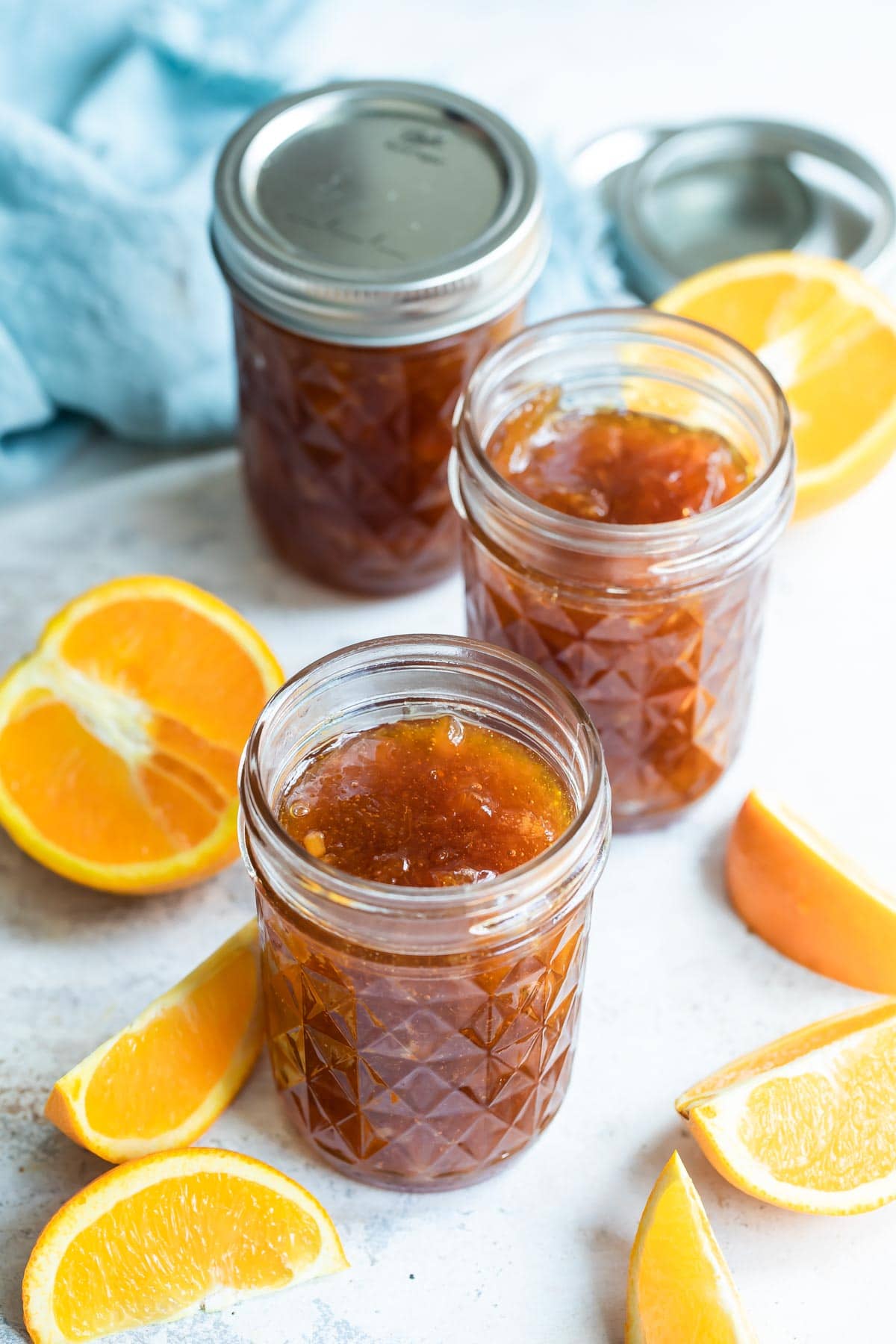
Nearly 1,000 5-star reviews prove this unfussy technique is simple and easy to follow. I also include my handy “cold plate test” so you can know for sure whether your marmalade is done or needs a little bit more time on the stove.
Home cooks everywhere are putting their abundant citrus to use to make their own homemade marmalade, and now you can, too. This recipe makes about 3 quarts total, or 12 (8 ounce jars). It freezes beautifully or you can process it in a water bath for canning.
Table of Contents
Marmalade Ingredients
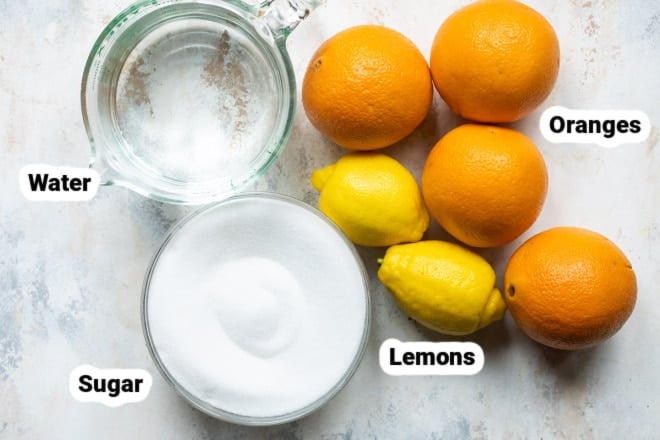
At a Glance: Here is a quick snapshot of what ingredients are in this recipe.
Please see the recipe card below for specific quantities.
- Oranges: This recipe is made with regular seedless oranges. You can definitely substitute Seville oranges if you can find them. They are only in season from the end of January to mid-February, but they have an intense flavor that is ideal for marmalade.
How to make Orange Marmalade
- Using a sharp knife, cut oranges and lemons in half crosswise, then into very thin half-moon slices. Discard any seeds. In a large pot (stainless steel), add the sliced oranges, lemons, and any fruit juice.
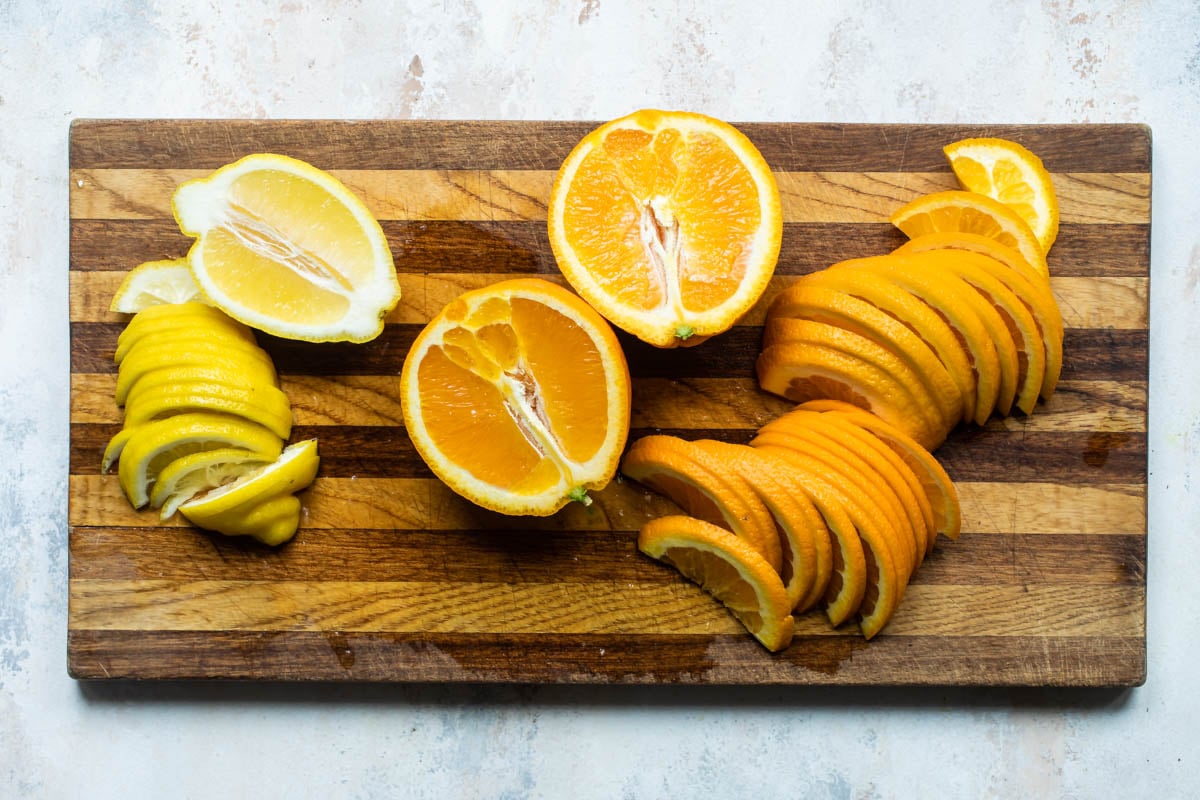
- Add water and bring the mixture to a boil over medium heat, stirring often. Remove from the heat and stir in the sugar until it dissolves. Cover and let stand overnight at room temperature.
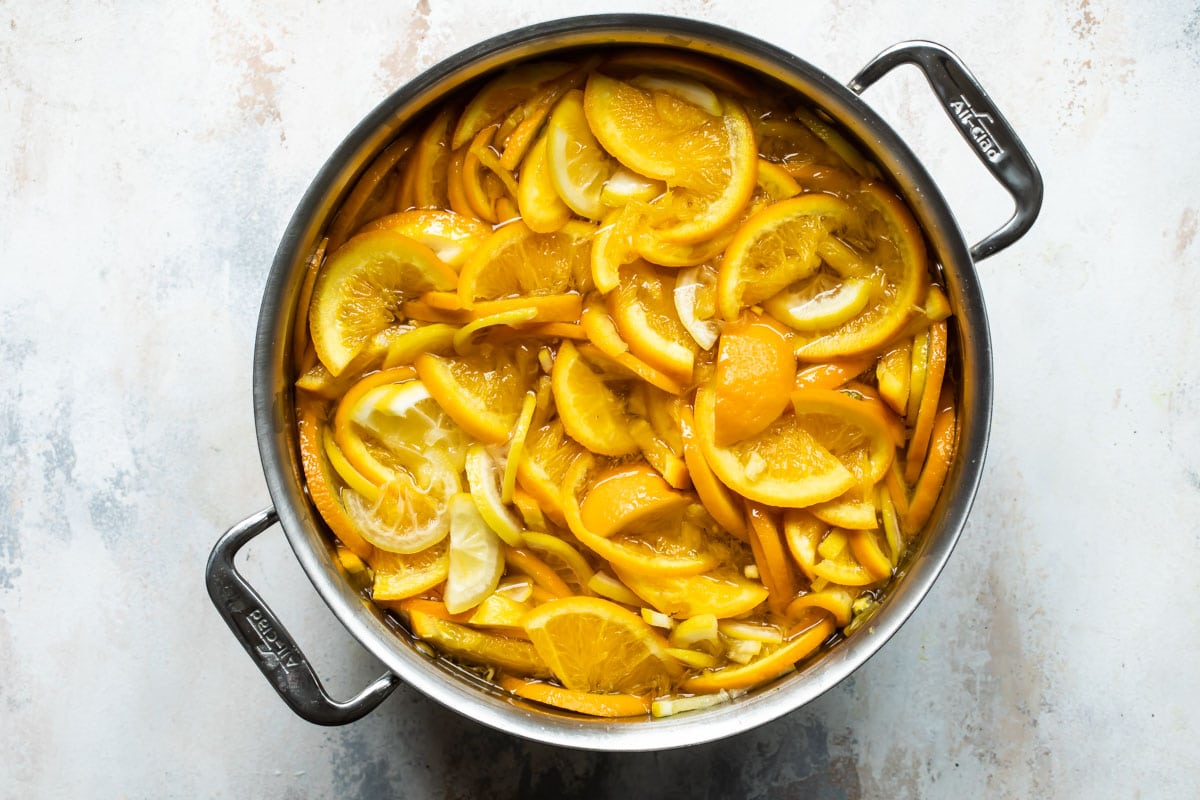
- The next day, bring the mixture back to a boil in the pot or saucepan. Reduce heat to low and simmer uncovered for 2 hours. Turn heat up to medium and boil gently, stirring often, for another 30 minutes. Skim off any foam that forms on the top. Cook until it reaches 220 degrees on a candy thermometer (you must hit this temperature for the natural pectin to gel with the sugar).
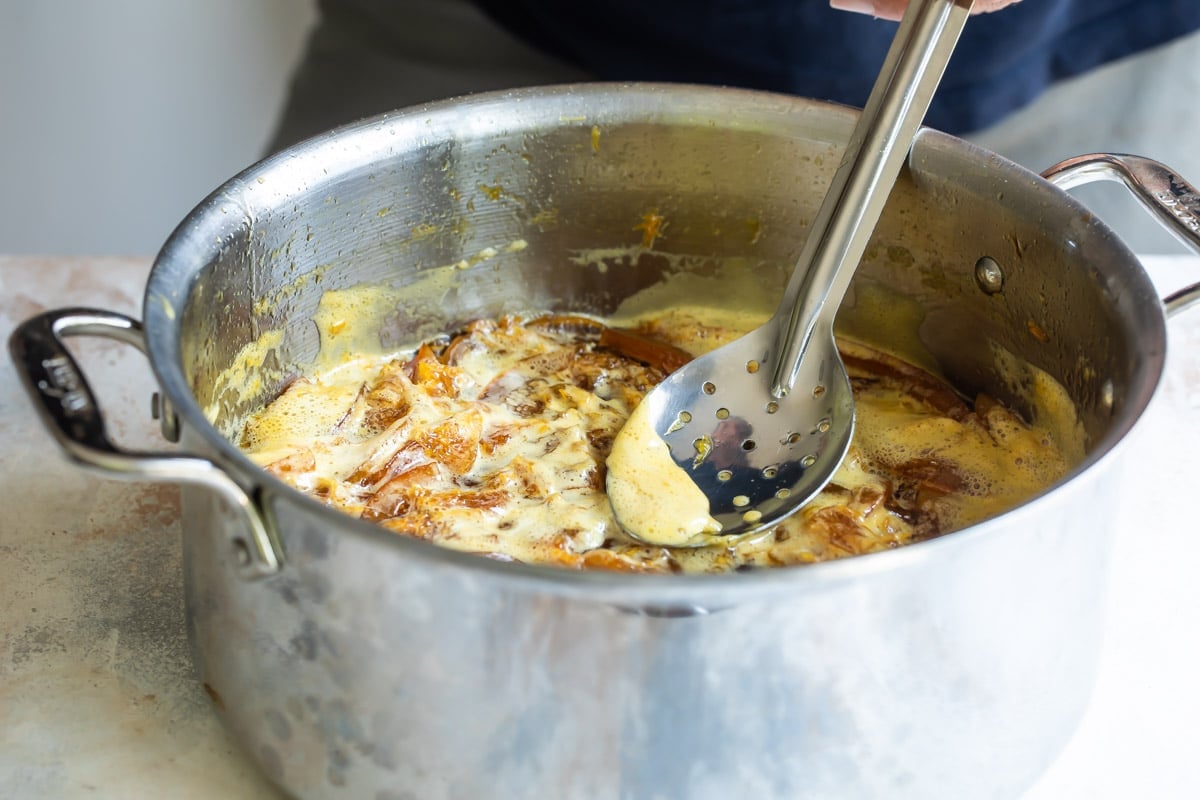
- To test if the marmalade is ready, place a small amount on a plate and refrigerate it until it’s cool but not cold. If it’s firm (neither runny nor hard), it’s ready. It will be a golden orange color. If it’s still runny, continue cooking it; if it’s hard, add a bit more water.
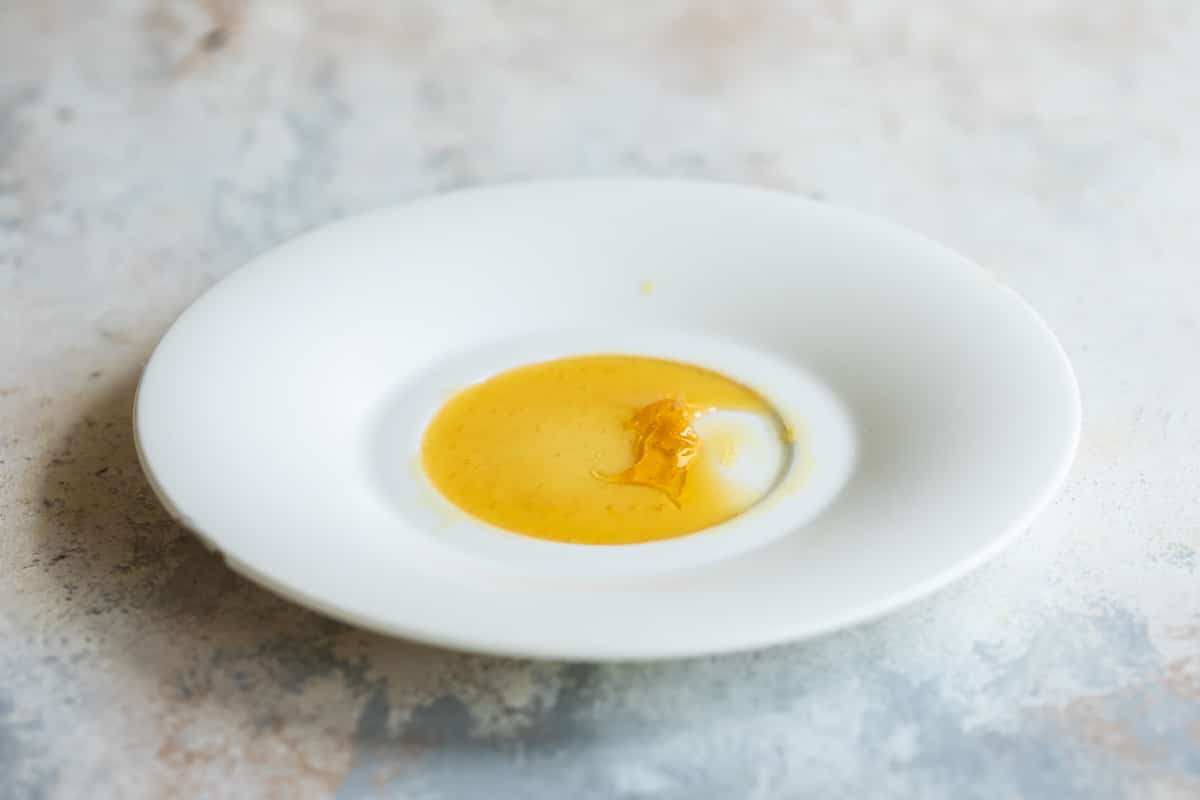
- Pour or ladle the marmalade into clean hot mason jars (I use this wide-mouth jar funnel for this recipe and so many others). Wipe the rims thoroughly with a clean damp paper towel, and seal with the lids. Chill in the refrigerator. It may take 24-48 hours for the natural pectin to set up properly.
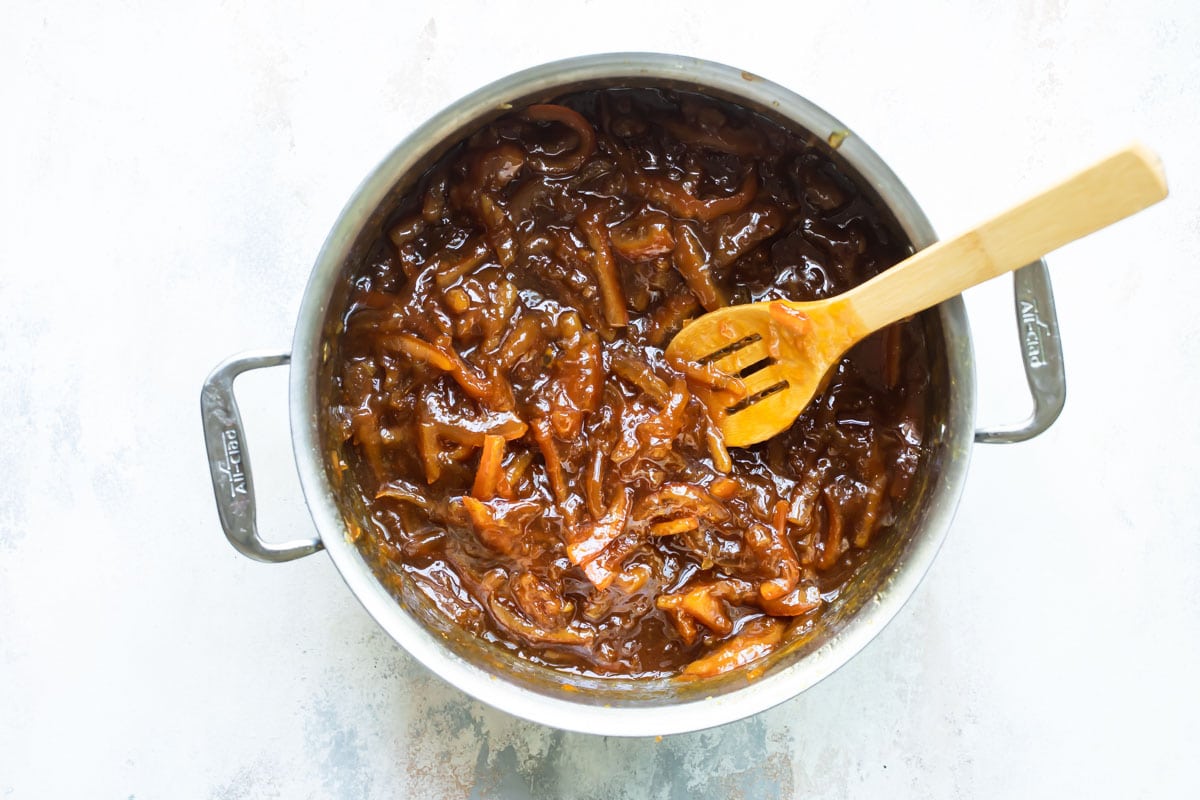
Orange Marmalade Recipe Variations
- Pectin: While many jam and jelly recipes require added pectin, you don’t need to add any here. Pectin is naturally concentrated in the pith of the orange (the bitter white part under the peel). This recipe coaxes out that natural pectin by letting the citrus soak overnight and then boiling it rapidly until enough water has evaporated that the mixture can reach 220 degrees.
- Agave nectar: Agave cannot penetrate and sweeten the peel as well as sugar can. When I tested it, the consistency was fine, but the rind tasted like raw rind. I don’t recommend this substitution.
- Low sugar: I haven’t tested low-sugar/alternative sweeteners in this recipe other than agave as listed above nor have I tweaked the amount of sugar in the recipe. I recommend seeking out recipes from experts in that area.
- Slow cooker: While it is technically possible to make marmalade in your slow cooker, it really depends on the power of your appliance. I no longer recommend that method because it isn’t reliable enough.
- Instant pot: Even with an overnight soak, the IP doesn’t break down the rind sufficiently. I don’t recommend this method.
Marmalade Recipe Tips
- Yield: This recipe makes about 3 quarts (96 ounces) of marmalade.
- If using 1/2-pint (8 ounce) jars, you’ll need 12.
- If using 1 pint (16 ounce) jars, you’ll need 6.
- If using the tiny jelly jars (4 ounce), you’ll need 24.
- Cold-plate test: To test if your marmalade is ready, spoon some hot marmalade on to a small plate and put it in the freezer to chill, or spoon some over an icy cold plate fresh from the freezer. If the mixture wrinkles slightly when you draw a spoon or finger across it, it has reached the setting point and is ready to go! If not, keep boiling and make sure the temperature reaches 220 degrees.
- Set-up time: Orange marmalade takes 24-48 hours for the natural pectin to set up completely. If it’s is still a little runny looking when it cools, check again in a day or two.
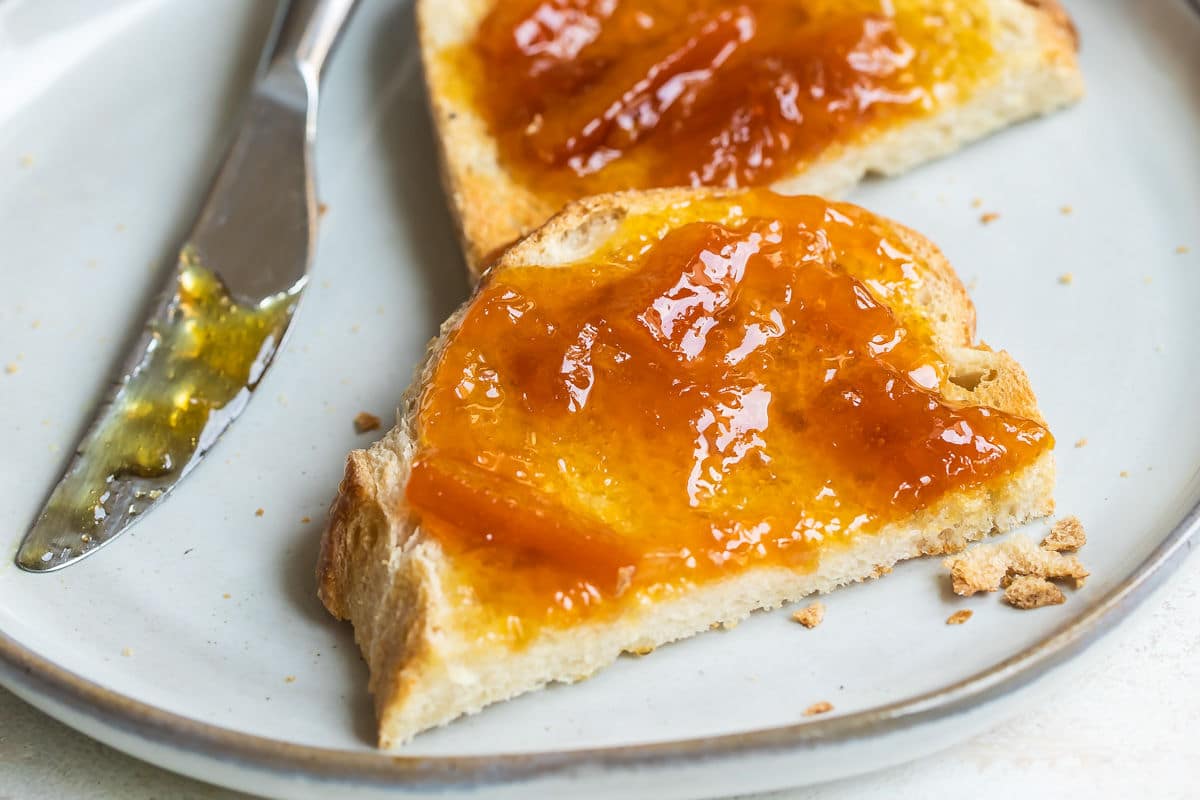
Storing and Canning Orange Marmalade
Storage: Store covered in the refrigerator for up to 1 month.
Freezer: Pack in freezer-safe containers or jars leaving 1/2-inch of headspace for expansion. Label, date, and freeze for up to 3 months. Thaw overnight in the refrigerator.
Canning: If putting up for storage, use a hot water or steam canner with a rack to properly seal lids on canning jars according to canning instructions. Otherwise, refrigerate and use within the month. Or, freeze for up to 3 months.
Frequently Asked Questions
Pectin is naturally concentrated in the pith of the orange (the bitter white part under the peel), so you don’t need to add any here. This recipe coaxes out that natural pectin by letting the citrus soak overnight and then boiling it rapidly until enough water has evaporated that the mixture can reach 220 degrees.
While it is technically possible to make marmalade in your slow cooker, it really depends on the power of your appliance. I no longer recommend that method because it isn’t reliable enough.
Even with an overnight soak, the IP doesn’t break down the rind sufficiently. I don’t recommend this method.
Agave cannot penetrate and sweeten the peel as well as sugar can. When I tested it, the consistency was fine, but the rind tasted like raw rind. I don’t recommend this substitution.
I don’t recommend making this recipe in a regular cast iron pan. It should be made in a non-reactive pan. Enameled cast iron, stainless steel, and non-stick are best and will not affect the color or taste of the marmalade
More fruit recipes
Pie and Tart Recipes
Fresh Fruit Tart
Fruit Dessert Recipes
Apple Crisp with Oatmeal
Cake Recipes
Lemon Bundt Cake Recipe
Muffins and Quick Breads
Banana Muffins
Join Us

Orange Marmalade
Equipment
- Jar funnel (for wide mouth jars)
Ingredients
- 4 large seedless oranges scrubbed clean (about 3 pounds or 8 cups slices, see note 1)
- 2 lemons (about ½ pound or 1 cup slices)
- 8 cups water
- 8 cups granulated sugar
Instructions
- Cut oranges and lemons in half crosswise, then into very thin half-moon slices. Discard any seeds. In a large stainless steel pot, add the sliced oranges, lemons, and any accumulated juices.
- Add water and bring the mixture to a boil, stirring often. Remove from the heat and stir in the sugar until it dissolves. Cover and let stand overnight at room temperature.
- The next day, bring the mixture back to a boil. Reduce heat to low and simmer uncovered for 2 hours. Turn heat up to medium and boil gently, stirring often, for another 30 minutes.
- Skim off any foam that forms on the top. Cook the marmalade until it reaches 220 degrees (you must hit this temperature for the natural pectin to gel with the sugar).
- To test if the marmalade is ready, place a small amount on a plate and refrigerate it until it's cool but not cold (see note 4). If it's firm (neither runny nor hard), it's ready. It will be a golden orange color. If the marmalade is runny, continue cooking it; if it's hard, add a bit more water.
- Pour the marmalade into clean hot mason jars; wipe the rims thoroughly with a clean damp paper towel, and seal with the lids. Chill in the refrigerator. It may take 24-48 hours for the natural pectin to set up properly.
Recipe Video
Notes
- Oranges: This recipe is made with regular seedless oranges. You can definitely substitute Seville oranges if you can find them. They are only in season from the end of January to mid-February, but they have an intense flavor that is ideal for marmalade.
- Yield: This recipe makes about 3 quarts (96 ounces) of marmalade.
- If using 1/2-pint (8 ounce) jars, you’ll need 12.
- If using 1 pint (16 ounce) jars, you’ll need 6.
- If using the tiny jelly jars (4 ounce), you’ll need 24.
- Storage: Store covered in the refrigerator for up to 1 month.
- Cold-plate test: To test if your marmalade is ready, spoon some hot marmalade on to a plate and put it in the freezer to chill, or spoon some over an icy cold plate fresh from the freezer. If the mixture wrinkles slightly when you draw a spoon or finger across it, it has reached the setting point and is ready to go! If not, keep boiling and make sure the temperature reaches 220 degrees.




For step 1, should we juice the fruit and just put the rinds in? Where is the juice is being referred to in this line (“Place the sliced fruit along with their juices“) coming from?
Hi Liv, sorry for the confusion about the way that is written. It just means the juices on the cutting board. You don’t juice the fruit, you just slice it, but in my experience you end up with a lot of juice on your board. So just dump that all in the pot. You slice the oranges (rinds and all) and put that in the pot. Sorry again. Thanks! -Meggan
Hi Meggan – I love your marmalade recipe as it’s so easy. Fortunately, I had bought a set of US measuring cups a few years ago as we weigh everything here. I only used 6 cups of sugar and added one lime for extra tang. It was a very soft set as I was a bit nervous on the rapid boil, but it tasted sublime! I’m now making my 2nd batch and trying out my new jam thermometer.
Many thanks.
Linda, Wales, UK.
Hi Linda, that’s great! I know the American measuring cups are so silly, but I’m glad you have a set. And I’m glad the marmalade worked out for you! I love hearing that. Thank you so much. -Meggan
Good day Megan,
I made my first batch of the jam but it is hard like jelly. How do I get it to the right consistency.
Patricia, from South Africa
Hi Patricia, it’s an easy fix! Just add more water until you get the consistency you want. Thank you! -Meggan
Also, it is still quite bitter, and no one in my family likes it…
Again – how long have you been cooking it? Probably not long enough. Please reserve judgement until you’ve completed the recipe. You need to cook it for 2 1/2 hours and then bring it to 220. Thanks. Sorry for the confusion. -Meggan
I made this a few months ago using oranges from our Orchard. They still had seeds in them but I thought what the hey….and threw them in. I only used 4 cups of sugar as the thought of 8 was making me ill LOL. I also added a Cinnamon stick AND Star Anise and followed your instructions and OMG….absolutely de-licious. It’s all gone now so will make another batch but this time going to experiment with Grapefruit and Oranges. By the way you might want to add that during the 2 hours of high intense heat (is that 220 degrees Fahrenheit? I’m in Australia so we use Celsius) that you don’t leave the pot unattended (duh). Hubby was not too pleased trying to scrape off the black bits off the bottom of his fave pot…for over week. But he LOVED the marmalade ☺️
I am blasting the gas on the power burner on my stove and cannot get it higher that 215 degrees Fahrenheit
How long have you been cooking it? You need to cook it for 2 1/2 hours before you can try to get it to 220 degrees. You need to cook the water off. Obviously water boils at 212 degrees. You can’t get the entire mixture above boiling point until enough water has been been cooked off.
Is this 220 degrees F?
Thanks, Liz
Hi Liz, yes, 220 degrees Farenheit. I live in the US so all the recipes are in Farenheit (for better or for worse). Thanks! -Meggan
On day two after simmering for two hours, how long do you boil? I was trying to boil for 30 minutes and a low boil but my temp came up to 220 degrees after about 15 minutes. I didn’t have a proper set even though the tempature was up. Any tips
Hi Ali, you need to simmer it for at least 2 hours and 30 minutes before worrying about the temperature. It takes a long time for the pectin to dissolve properly so it will set up. You can always throw it back on the stove and cook it some more. Thanks! -Meggan
Hi! I live in Costa Rica snd I have an orange tree that produces a variety of orange that us sour and has green skin. It is orange inside. Think they will work?
Hi Myrs, I think it is worth a try if you have some sugar. You could even make a smaller batch and just see what happens. I think it would work because the pith should have pectin. As for the taste, I’m not sure! But with so much sugar, I don’t see how it could be bad. I think it is worth trying if that is what you have. I hope you are doing well in Costa Rica! -Meggan
Question do I need to blanch the fruit first to remove the bitterness of the pith or not?
Hi Lucas, no you don’t. This recipe includes an overnight soak in sugar water which softens and sweetens the pith (while also releasing the natural pectin in the pith). So by the time you’re done making it, it will taste like marmalade. It has a hint of bitterness the way marmalade does, but overall there is so much sugar, it’s very sweet. Thanks for the question! -Meggan
I never in a million years thought I could make my own marmalade! It is delicious! I feel like Paddington!